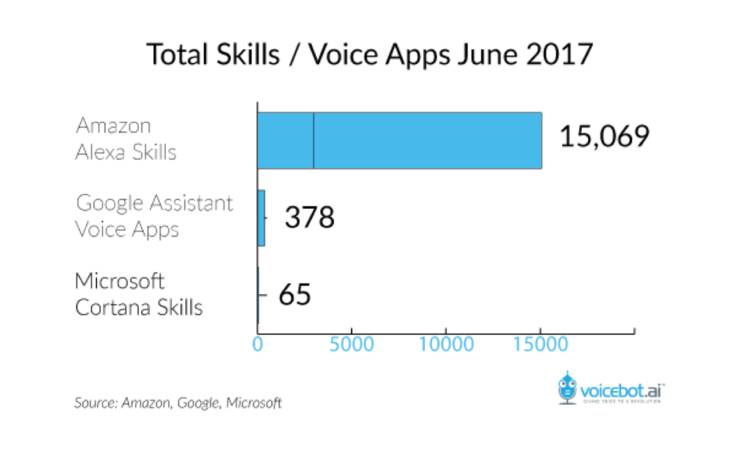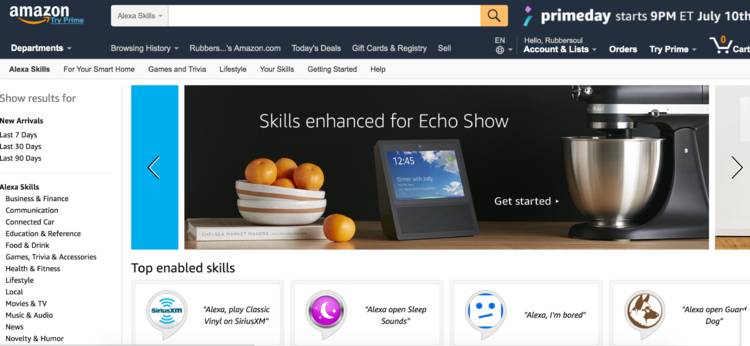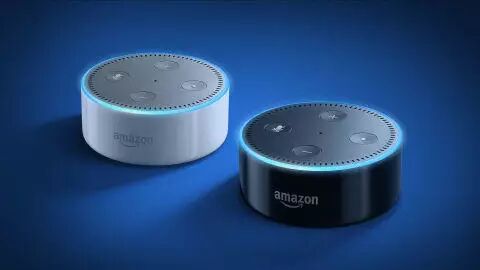Summary: Amazon is dominating the smart speaker market, and recent data once again proves its king status.
The Amazon Echo has sparked a craze for smart speakers, with more and more internet companies diving in to develop or launch their own consumer products. However, in this smart speaker race, significant resource investment combined with a friendly and open developer platform has allowed Amazon to maintain a considerable lead.
According to a research report from May this year, Amazon Echo’s market share has reached 70.6%, far ahead of other brands like Lenovo, LG, and Harman Kardon. In other words, Amazon is dominating the smart speaker market in the United States. Recent data further confirms Amazon’s king status in the smart speaker field.
According to foreign media Voicebot.ai (http://t.cn/RoFZaXB), the number of skills for Amazon Alexa has exceeded 15,000, far surpassing competitors Google Assistant and Microsoft’s Cortana. In January of this year, this number was only 7,000, meaning that the number of Alexa skills has doubled in the past six months, reaching a total of 15,069.

Meanwhile, Alexa has also launched thousands of skills in the UK and Germany, although some of these can only be used in those countries, while others are just localized versions of Alexa’s US skills. While it is currently difficult to accurately count the total number of Alexa skills globally, it is certain that this number has reached around 20,000.
In addition to having 15,000 skills, another noteworthy point is the speed at which Amazon is introducing new skills. In the first three months of 2017, the growth rate of Alexa skills was less than 10%, but by June, it had increased to 23%. This growth rate is roughly comparable to the monthly increase of Google Voice applications, but due to the larger base, the number of new skills added to Alexa far exceeds that of Google.
In June, Amazon Alexa gained 2,779 new skills, while Google Assistant only added 74 new applications. The growth rate of Alexa skills is more than 37 times that of Google Assistant.
In terms of skill types, “Flash Briefings” remain one of the most popular skills on Alexa. The duration of a “Flash Briefing” program is generally around 90 seconds, and users can simply say to Alexa, “Alexa, give me today’s news briefing,” and Echo will immediately start broadcasting the latest news program. Moreover, developing this information-based skill is quite simple, and many media outlets have recognized this cool smart home technology, hoping to get a piece of the pie in the new tech field.

Media outlets such as The Wall Street Journal, The Washington Post, Digiday, and NPR have early adopted Alexa and have become the “cornerstones” of Alexa’s early skill store. However, in the second quarter of 2017, “Flash Briefing” skills showed a negative growth trend. On April 1, “Flash Briefings” accounted for 24% of the total number of Alexa skills in the US, but this proportion dropped to 23% in early May, 22% on June 1, and only 20% by early July. Currently, the number of “Flash Briefing” skills is 2,891.
Google and Microsoft Need to Encourage Developers
Skills on Google Assistant are not called “skills”; they were originally called Actions and later renamed Voice Apps, while Microsoft’s Cortana, like Amazon’s Alexa, uses the term “skills.” As of June 30, Google Assistant only has 378 voice applications. Cortana has even fewer, with only 65, and its growth rate is only 12% each time.
Many people often say that Google Assistant is stronger than Alexa in certain aspects. Indeed, information search is Google’s strong suit and Alexa’s weak point, but when it comes to tasks that voice assistants can help users complete, Alexa’s advantages are still quite clear. The skills of Alexa and the voice applications of Google are generally not too complex, at least in terms of operation.
Although some critics argue that Alexa has many low-quality skills, we should not forget the “long tail theory” in sales (http://t.cn/RoFZWXK). Not all skills are as practical as calling a ride or having NPR play the news, but the fact is that the more skills a platform has, the greater the chance users will discover “good skills.”

Amazon’s attitude towards Alexa is very open. In June last year, Amazon opened up Alexa’s API to developers, allowing it to spread rapidly and helping Alexa grow faster.
It is worth mentioning that Amazon has also established the Alexa Fund, planning to invest $100 million to help small and medium-sized enterprises and startups develop Alexa-related technologies. At the 2017 CES, an audio manufacturer stated that the chip cost for integrating Alexa into ordinary devices is low enough to be acceptable, and Amazon provides very detailed guidance, making development work very convenient.
As the scale grows, maintaining a high growth rate of skills becomes a challenging task, but Amazon has managed to do it. Google and Microsoft both have large and well-established developer communities, and logically, they should have mobilized all their resources to showcase their prowess on the new voice platform, but for some reason, they have yet to deliver tangible results.
Most developers of Google Assistant’s voice applications and Microsoft’s Cortana skills have previously participated in the development of Amazon Alexa. However, Google and Microsoft seem to have failed to successfully “activate” their developer communities, sparking interest in their voice platforms. Perhaps they will catch up later, but it is clear that currently only Alexa’s developers are highly enthusiastic. If the developers of the other two voice devices continue to remain “inactive,” they will surely be left further behind by Amazon’s Alexa.
Leading in Quantity, But What Next?
Although Alexa’s skill count is now quite impressive, as mentioned above, many of these skills are of low quality. Moreover, the distribution of Alexa’s skills in usage is also very uneven; some simple controls (like turning lights on and off) are used very frequently, while most users try out more complex functions only once and then abandon them.
According to data obtained by Geek Park from relevant domestic practitioners, among all users who have used Alexa, 34% have used the music playback function, 30% have used light control, and 25% have used the timer function—more still rely on basic control functions, while services like ride-hailing and shopping do not occupy a large proportion. As for usage scenarios, 50% occur in the kitchen, primarily among homemakers.

Currently, Alexa’s applications are still mostly concentrated on executing simple commands, which is also its advantage. How to enhance the “dimension” of skills in the future and how to more intuitively showcase new skills to users will be the areas Amazon needs to consider moving forward.
From the recently released Echo Show, it can be seen that Amazon is already trying to increase the complexity of interactions by adding a screen to the smart speaker, which will provide more display and application space for the continuously increasing skills. Perhaps soon, the standard of measuring a speaker’s “intelligence” solely by the number of skills will no longer exist.
Editor: Rubberso
References: Voicebot.ai (http://t.cn/RoFZaXB)
This article is originally from Geek Park
For reprint inquiries, contact [email protected]


